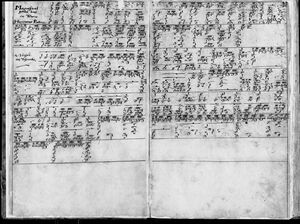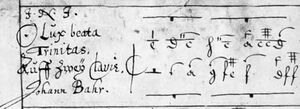Visby Tablature: Difference between revisions
Fiskfan1999 (talk | contribs) Create page Tag: visualeditor |
Fiskfan1999 (talk | contribs) m Text replacement - "Swedish manuscripts" to "Swedish Manuscripts" |
||
| (12 intermediate revisions by 2 users not shown) | |||
| Line 1: | Line 1: | ||
S-VIl SE/ViLA/20021/H/3 (also known as the '''Visby Tablature''' or ''Orgeltabulatur Petri-Bahr'') is an organ manuscript held in the Riksarkivet Landsarkivet i Visby, containing organ works by [[Hieronymus Praetorius|Hieronymus]] and [[ | S-VIl SE/ViLA/20021/H/3 (also known as the '''Visby Tablature''' or ''Orgeltabulatur Petri-Bahr'') is an organ manuscript held in the Riksarkivet Landsarkivet i Visby, containing organ works by [[Hieronymus Praetorius|Hieronymus]] and [[Jacob Praetorius]], [[Johann Bahr]], and several anonymous pieces. | ||
== Description == | == Description == | ||
Almost all of the pieces in the tablature were written by [[Berendt Petri]] while he was studying under Jakob Praetorius. The copies were likely made from assorted loose leaves, which may have been mixed up (some evidence for this is that part of a [[Chorale Fantasia]] ''Ach Gott vom Himmel siehe darein'')<ref name=":0">Beckmann, Klaus (editor). ''Hieronymus Praetorius: Sämtliche Orgelwerke'', vol. 1. Meister der norddeutschen Orgelschule 1. Mainz: Schott, 2003.</ref>. | [[File:Praetorius Magnificat Primi Toni.jpg|thumb|The first and second verse of ''Magnificat Primi Toni'' by [[Hieronymus Praetorius]]]] | ||
Almost all of the pieces in the tablature were written by [[Berendt Petri]] while he was studying under Jakob Praetorius. The copies were likely made from assorted loose leaves, which may have been mixed up (some evidence for this is that part of a [[Chorale Fantasia]] ''Ach Gott vom Himmel siehe darein'' which appears in the middle of a verse of the ''Magnificat septimi toni'')<ref name=":0">Beckmann, Klaus (editor). ''Hieronymus Praetorius: Sämtliche Orgelwerke'', vol. 1. Meister der norddeutschen Orgelschule 1. Mainz: Schott, 2003.</ref>. | |||
The pieces written by both copyists are in [[New German Tablature Notation]]. Some pieces have a stylized ''f'' at the end of a multi-verse work signyfing "finis" (for an unknown reason, this symbol also appears at the end of the third verse of the five-verse setting of the ''Magnificat septimi toni''). | |||
The manuscript was first owned by its scribe, [[Berendt Petri]], and the writing on the title page was dated 1611. Since two pieces are dated 1609 and 1603, this suggests that the pieces within were written between these years (additionally, since some of the Magnificats by Hieronymus Praetorius use motives found in his vocal Magnificats, it is possible that the organ Magnificats were composed after they were published in 1602). After this, the manuscript was owned by Johann Bahr. Two dates found in pieces written in the manuscript by him are 1655 and 1666. | |||
The first time that the manuscript became known to modern musicologists is in 1891 by [[Adolf Lindgren]]. After this, the next research on this manuscript was undertaken in 1914 by Anrep-Nordin, who published a series of articles on [[Johann Bahr]] and his works in the manuscript, as well as the ''Magnificat germanice'' by [[Jacob Praetorius]]. For the 9th German Bach Festical in Hamburg on 1921, the Visby Tablature was assigned number 460 in the catalogue of manuscripts. Between 1921-1934 more research was published on this manuscript. | |||
The pieces | The first musical edition of music from the Visby Tablature was the inclusion of both pieces by Jacob Praetorius in 1957<ref>[[Giesela Gerdes|Gerdes, Giesela]] (editor), ''46 Choräle für Orgel von J. P. Sweelinck und seinen Schülern.'' Mainz: Schott, 1957.</ref>. In 1963, the first edition of the Magnificats was published as the 4th volume of [[Corpus of Early Keyboard Music]] by [[Clare Rayner]]. | ||
== Johann Bahr == | |||
[[File:BahrOLux.jpg|thumb|right|The autograph manuscript of ''O Lux beata Trinitas'' by Johann Bahr]] | |||
At a later point, [[Johann Bahr]] became the owner of the manuscript. During this time he wrote four of his own compositions (including the only two vocal cantatas in the manuscript) in some (but not all) of the remaining blank pages. These pieces are in a lighter hand, and two of them are dated 1655 and 1666. These are the only four pieces by Bahr which survive to the modern day. | |||
== Anonymous Pieces == | == Anonymous Pieces == | ||
| Line 17: | Line 26: | ||
[[Jeffery T. Kite-Powell|Kite-Powell, Jeffery T.]] (editor). ''The Visby (Petri) Organ Tablature: Investigation and Critical Edition.'' Wilhelmshaven: Heinrichschofen's Verlag, 1979. | [[Jeffery T. Kite-Powell|Kite-Powell, Jeffery T.]] (editor). ''The Visby (Petri) Organ Tablature: Investigation and Critical Edition.'' Wilhelmshaven: Heinrichschofen's Verlag, 1979. | ||
A complete scan of the tablature is available | [https://sok.riksarkivet.se/arkiv/gyqHzRbuYnDirmntWnHU45 sok.riksarkivet.se], accessed 15 August, 2023. | ||
A complete scan of the tablature is available at [https://sok.riksarkivet.se/bildvisning/J0000003_00001 sok.riksarkivet.se], mirrored {{IMSLP|839399}} | |||
[[Category:Manuscripts|Visby Tablature]] | |||
[[Category:Tablatures|Visby Tablature]] | |||
[[Category:Swedish Manuscripts|Visby Tablature]] | |||
Latest revision as of 19:54, 13 November 2024
S-VIl SE/ViLA/20021/H/3 (also known as the Visby Tablature or Orgeltabulatur Petri-Bahr) is an organ manuscript held in the Riksarkivet Landsarkivet i Visby, containing organ works by Hieronymus and Jacob Praetorius, Johann Bahr, and several anonymous pieces.
Description

Almost all of the pieces in the tablature were written by Berendt Petri while he was studying under Jakob Praetorius. The copies were likely made from assorted loose leaves, which may have been mixed up (some evidence for this is that part of a Chorale Fantasia Ach Gott vom Himmel siehe darein which appears in the middle of a verse of the Magnificat septimi toni)[1].
The pieces written by both copyists are in New German Tablature Notation. Some pieces have a stylized f at the end of a multi-verse work signyfing "finis" (for an unknown reason, this symbol also appears at the end of the third verse of the five-verse setting of the Magnificat septimi toni).
The manuscript was first owned by its scribe, Berendt Petri, and the writing on the title page was dated 1611. Since two pieces are dated 1609 and 1603, this suggests that the pieces within were written between these years (additionally, since some of the Magnificats by Hieronymus Praetorius use motives found in his vocal Magnificats, it is possible that the organ Magnificats were composed after they were published in 1602). After this, the manuscript was owned by Johann Bahr. Two dates found in pieces written in the manuscript by him are 1655 and 1666.
The first time that the manuscript became known to modern musicologists is in 1891 by Adolf Lindgren. After this, the next research on this manuscript was undertaken in 1914 by Anrep-Nordin, who published a series of articles on Johann Bahr and his works in the manuscript, as well as the Magnificat germanice by Jacob Praetorius. For the 9th German Bach Festical in Hamburg on 1921, the Visby Tablature was assigned number 460 in the catalogue of manuscripts. Between 1921-1934 more research was published on this manuscript.
The first musical edition of music from the Visby Tablature was the inclusion of both pieces by Jacob Praetorius in 1957[2]. In 1963, the first edition of the Magnificats was published as the 4th volume of Corpus of Early Keyboard Music by Clare Rayner.
Johann Bahr

At a later point, Johann Bahr became the owner of the manuscript. During this time he wrote four of his own compositions (including the only two vocal cantatas in the manuscript) in some (but not all) of the remaining blank pages. These pieces are in a lighter hand, and two of them are dated 1655 and 1666. These are the only four pieces by Bahr which survive to the modern day.
Anonymous Pieces
The tablature contains many pieces with no composer attribution, all multi-verse chorale settings which were likely meant for Alternatum use. Professor Kite-Powell attributed all of these pieces to Hieronymus Praetorius on stylistic grounds, such as similarities in motivic fragments and diminutions to the attributed Magnificats. These attributions are generally accepted now and these pieces are included in the complete organ works edited by Klaus Beckmann[1].
Contents
The Kite-Powell edition contains a complete transcription of the tablature into stave notation (including the vocal cantatas by Bahr).
Reference
Kite-Powell, Jeffery T. (editor). The Visby (Petri) Organ Tablature: Investigation and Critical Edition. Wilhelmshaven: Heinrichschofen's Verlag, 1979.
sok.riksarkivet.se, accessed 15 August, 2023.
A complete scan of the tablature is available at sok.riksarkivet.se, mirrored IMSLP839399
- ↑ 1.0 1.1 Beckmann, Klaus (editor). Hieronymus Praetorius: Sämtliche Orgelwerke, vol. 1. Meister der norddeutschen Orgelschule 1. Mainz: Schott, 2003.
- ↑ Gerdes, Giesela (editor), 46 Choräle für Orgel von J. P. Sweelinck und seinen Schülern. Mainz: Schott, 1957.